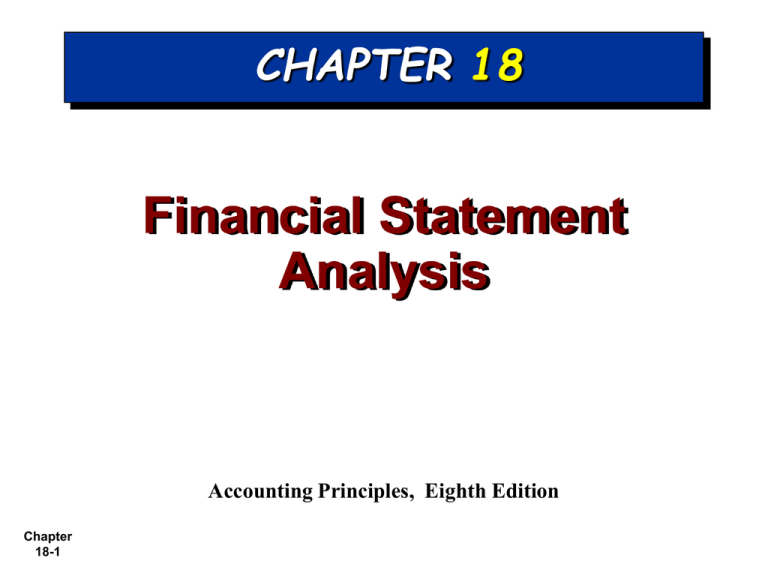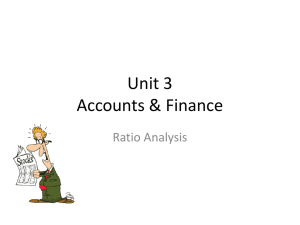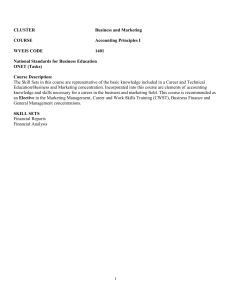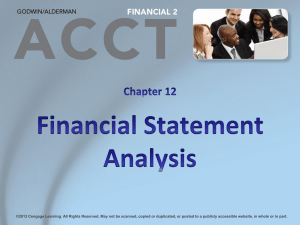Financial Accounting and Accounting Standards
advertisement

CHAPTER 18 Financial Statement Analysis Accounting Principles, Eighth Edition Chapter 18-1 Study Objectives 1. Discuss the need for comparative analysis. 2. Identify the tools of financial statement analysis. 3. Explain and apply horizontal analysis. 4. Describe and apply vertical analysis. 5. Identify and compute ratios used in analyzing a firm’s liquidity, profitability, and solvency. 6. Understand the concept of earning power, and how irregular items are presented. 7. Understand the concept of quality of earnings. Chapter 18-2 Financial Statement Analysis Basics of Financial Statement Analysis Need for comparative analysis Tools of analysis Horizontal and Vertical Analysis Ratio Analysis Balance sheet Liquidity Income statement Solvency Retained earnings statement Profitability Summary Earning Power and Irregular Items Discontinued operations Extraordinary items Changes in accounting principle Comprehensive income Chapter 18-3 Quality of Earnings Alternative accounting methods Pro forma income Improper recognition Basics of Financial Statement Analysis Analyzing financial statements involves: Comparison Bases Characteristics Liquidity Intracompany Horizontal Profitability Industry averages Vertical Solvency Chapter 18-4 Tools of Analysis Intercompany LO 1 LO 2 Ratio Discuss the need for comparative analysis. Identify the tools of financial statement analysis. Horizontal Analysis Horizontal analysis, also called trend analysis, is a technique for evaluating a series of financial statement data over a period of time. Its purpose is to determine the increase or decrease that has taken place. Horizontal analysis is commonly applied to the balance sheet, income statement, and statement of retained earnings. Chapter 18-5 LO 3 Explain and apply horizontal analysis. Horizontal Analysis Exercise: The comparative condensed balance sheets of Ramsey Corporation are presented below. Current assets PP&E Intangibles Total assets 2009 $ 76,000 99,000 25,000 $ 200,000 2008 $ 80,000 90,000 40,000 $ 210,000 Current liabilities Long-term liabilties Stockholders' equity Total liabilities & equity $ 40,800 143,000 16,200 $ 200,000 $ 48,000 150,000 12,000 $ 210,000 Instructions: Prepare a horizontal analysis of the balance sheet data for Ramsey Corporation using 2008 as a base. Chapter 18-6 LO 3 Explain and apply horizontal analysis. Horizontal Analysis Exercise: The comparative condensed balance sheets of Ramsey Corporation are presented below. Current assets PP&E Intangibles Total assets 2009 $ 76,000 99,000 25,000 $ 200,000 2008 $ 80,000 90,000 40,000 $ 210,000 Current liabilities Long-term liabilties Stockholders' equity Total liabilities & equity $ 40,800 143,000 16,200 $ 200,000 $ 48,000 150,000 12,000 $ 210,000 Increase Percentage (Decrease) Change $ (4,000) -5.0% 9,000 10.0% (15,000) -37.5% $ (10,000) -4.8% $ (7,200) (7,000) 4,200 $ (10,000) -15.0% -4.7% 35.0% -4.8% Instructions: Prepare a horizontal analysis of the balance sheet data for Ramsey Corporation using 2008 as a base. Chapter 18-7 LO 3 Explain and apply horizontal analysis. Vertical Analysis Vertical analysis, also called common-size analysis, is a technique that expresses each financial statement item as a percent of a base amount. On an income statement, we might say that selling expenses are 16% of net sales. Vertical analysis is commonly applied to the balance sheet and the income statement. Chapter 18-8 LO 4 Describe and apply vertical analysis. Vertical Analysis Exercise: The comparative condensed income statements of Hendi Corporation are shown below. Net sales Cost of goods sold Gross profit Operating expense Net income 2009 Amount $ 600,000 483,000 117,000 57,200 $ 59,800 2008 Amount $ 500,000 420,000 80,000 44,000 $ 36,000 Instructions: Prepare a vertical analysis of the income statement data for Hendi Corporation in columnar form for both years. Chapter 18-9 LO 4 Describe and apply vertical analysis. Vertical Analysis Exercise: The comparative condensed income statements of Hendi Corporation are shown below. Net sales Cost of goods sold Gross profit Operating expense Net income 2009 Amount Percent $ 600,000 100.0% 483,000 80.5% 117,000 19.5% 57,200 9.5% $ 59,800 10.0% 2008 Amount Percent $ 500,000 100.0% 420,000 84.0% 80,000 16.0% 44,000 8.8% $ 36,000 7.2% Instructions: Prepare a vertical analysis of the income statement data for Hendi Corporation in columnar form for both years. Chapter 18-10 LO 4 Describe and apply vertical analysis. Ratio Analysis Ratio analysis expresses the relationship among selected items of financial statement data. Financial Ratio Classifications Chapter 18-11 Liquidity Profitability Solvency Measures shortterm ability of the company to pay its maturing obligations and to meet unexpected needs for cash. Measures the income or operating success of a company for a given period of time. Measures the ability of the company to survive over a long period of time. LO 5 Identify and compute ratios used in analyzing a firm’s liquidity, profitability, and solvency. Ratio Analysis A single ratio by itself is not very meaningful. The discussion of ratios will include the following types of comparisons. Chapter 18-12 LO 5 Identify and compute ratios used in analyzing a firm’s liquidity, profitability, and solvency. Ratio Analysis Liquidity Ratios Measure the short-term ability of the company to pay its maturing obligations and to meet unexpected needs for cash. Short-term creditors such as bankers and suppliers are particularly interested in assessing liquidity. Ratios include the current ratio, the acid-test ratio, receivables turnover, and inventory turnover. Chapter 18-13 LO 5 Identify and compute ratios used in analyzing a firm’s liquidity, profitability, and solvency. Ratio Analysis Taylor Tool Company Illustration Income Statement For the Year Ended December 31 2009 2008 $ 1,818,500 $ 1,750,500 1,011,500 996,000 Gross profit 807,000 754,500 Selling and administrative expenses 506,000 479,000 Income from operations 301,000 275,500 18,000 14,000 283,000 261,500 84,000 77,000 Net sales Cost of goods sold Other expenses and losses: Interest expense Income before income taxes Income tax expense Net income Chapter 18-14 $ 199,000 $ 184,500 LO 5 Identify and compute ratios used in analyzing a firm’s liquidity, profitability, and solvency. Ratio Analysis Taylor Tool Company Balance Sheets December 31 Assets 2009 2008 Current assets Cash $ Short-term investments $ 64,200 69,000 50,000 Accounts receivable (net) 107,800 102,800 Inventory 133,000 115,500 369,900 332,500 600,300 520,300 Total current assets Plant assets (net) Total assets Chapter 18-15 60,100 $ 970,200 $ 852,800 LO 5 Identify and compute ratios used in analyzing a firm’s liquidity, profitability, and solvency. Ratio Analysis Liabilities and Stockholders' Equity 2009 2008 Current liabilities Accounts payable $ Income taxes payable 160,000 $ 145,400 43,500 42,000 203,500 187,400 200,000 200,000 403,500 387,400 Common stock ($5 par) 280,000 300,000 Retained earnings 286,700 165,400 566,700 465,400 Total current liabilities Bonds payable Total liabilities Stockholders' equity Total stockholders' equity Total liabilities and equity $ 970,200 $ 852,800 All sales were on account. The allowance for doubtful accounts was $3,200 on December 31, 2009, and $3,000 on December 31, 2008. Chapter 18-16 LO 5 Identify and compute ratios used in analyzing a firm’s liquidity, profitability, and solvency. Ratio Analysis Liquidity Ratios Compute the Current Ratio for 2009. Current Assets Current Liabilities $369,900 $203,500 = Current Ratio = 1.82 : 1 The ratio of 1.82:1 means that for every dollar of current liabilities, the company has $1.82 of current assets. Chapter 18-17 LO 5 Identify and compute ratios used in analyzing a firm’s liquidity, profitability, and solvency. Ratio Analysis Liquidity Ratios Compute the Acid-Test Ratio for 2009. Cash + Short-Term Investments + Receivables (Net) Current Liabilities $60,100 + $69,000 + $107,800 $203,500 = Acid-Test Ratio = 1.16 : 1 The acid-test ratio measures immediate liquidity. Chapter 18-18 LO 5 Identify and compute ratios used in analyzing a firm’s liquidity, profitability, and solvency. Ratio Analysis Liquidity Ratios Compute the Receivables Turnover ratio for 2009. Net Credit Sales Average Net Receivables $1,818,500 ($107,800 + $102,800) / 2 = Receivables Turnover = 17.3 times It measures the number of times, on average, the company collects receivables during the period. Chapter 18-19 LO 5 Identify and compute ratios used in analyzing a firm’s liquidity, profitability, and solvency. Ratio Analysis Liquidity Ratios Receivables Turnover = 17.3 times ($107,800 + $102,800) / 2 $1,818,500 A variant of the receivables turnover ratio is to convert it to an average collection period in terms of days. 365 days / 17.3 times = every 21.1 days This means that receivables are collected on average every 21 days. Chapter 18-20 LO 5 Identify and compute ratios used in analyzing a firm’s liquidity, profitability, and solvency. Ratio Analysis Liquidity Ratios Compute the Inventory Turnover ratio for 2009. Cost of Good Sold Average Inventory $1,011,500 ($133,000 + $115,500) / 2 = Inventory Turnover = 8.1 times Inventory turnover measures the number of times, on average, the inventory is sold during the period. Chapter 18-21 LO 5 Identify and compute ratios used in analyzing a firm’s liquidity, profitability, and solvency. Ratio Analysis Liquidity Ratios Inventory Turnover = 8.1 times ($133,000 + $115,500) / 2 $1,011,500 A variant of inventory turnover is the days in inventory. 365 days / 8.1 times = every 45.1 days Inventory turnover ratios vary considerably among industries. Chapter 18-22 LO 5 Identify and compute ratios used in analyzing a firm’s liquidity, profitability, and solvency. Ratio Analysis Profitability Ratios Measure the income or operating success of a company for a given period of time. Income, or the lack of it, affects the company’s ability to obtain debt and equity financing, liquidity position, and the ability to grow. Ratios include the profit margin, asset turnover, return on assets, return on common stockholders’ equity, earnings per share, price-earnings, and payout ratio. Chapter 18-23 LO 5 Identify and compute ratios used in analyzing a firm’s liquidity, profitability, and solvency. Ratio Analysis Profitability Ratios Compute the Profit Margin ratio for 2009. Net Income Net Sales $199,000 $1,818,500 = Profit Margin = 10.9% Measures the percentage of each dollar of sales that results in net income. Chapter 18-24 LO 5 Identify and compute ratios used in analyzing a firm’s liquidity, profitability, and solvency. Ratio Analysis Profitability Ratios Compute the Asset Turnover ratio for 2009. Net Sales Average Assets $1,818,500 ($970,200 + $852,800) / 2 = Asset Turnover = 2.0 times Measures how efficiently a company uses its assets to generate sales. Chapter 18-25 LO 5 Identify and compute ratios used in analyzing a firm’s liquidity, profitability, and solvency. Ratio Analysis Profitability Ratios Compute the Return on Assets ratio for 2009. Net Income Average Assets $199,000 ($970,200 + $852,800) / 2 = Return on Assets = 21.8% An overall measure of profitability. Chapter 18-26 LO 5 Identify and compute ratios used in analyzing a firm’s liquidity, profitability, and solvency. Ratio Analysis Profitability Ratios Compute the Return on Common Stockholders’ Equity ratio for 2009. Return on Net Income – Preferred Dividends Common = Stockholders’ Average Common Stockholders’ Equity Equity $199,000 - $0 ($566,700 + $465,400) / 2 = 38.6% Shows how many dollars of net income the company earned for each dollar invested by the owners. Chapter 18-27 LO 5 Identify and compute ratios used in analyzing a firm’s liquidity, profitability, and solvency. Ratio Analysis Profitability Ratios Compute the Earnings Per Share for 2009. Net Income Weighted Average Common Shares Outstanding $199,000 57,000 (given) = Earnings Per Share = $3.49 per share A measure of the net income earned on each share of common stock. Chapter 18-28 LO 5 Identify and compute ratios used in analyzing a firm’s liquidity, profitability, and solvency. Ratio Analysis Profitability Ratios Compute the Price Earnings Ratio for 2009. Market Price per Share of Stock Earnings Per Share $25 (given) $3.49 = Price Earnings Ratio = 7.16 times The price-earnings (PE) ratio reflects investors’ assessments of a company’s future earnings. Chapter 18-29 LO 5 Identify and compute ratios used in analyzing a firm’s liquidity, profitability, and solvency. Ratio Analysis Profitability Ratios Compute the Payout Ratio for 2009. Cash Dividends Net Income $77,700 * $199,000 = Payout Ratio = 39% Measures the percentage of earnings distributed in the form of cash dividends. * From analysis of retained earnings. Chapter 18-30 LO 5 Identify and compute ratios used in analyzing a firm’s liquidity, profitability, and solvency. Ratio Analysis Solvency Ratios Solvency ratios measure the ability of a company to survive over a long period of time. Debt to total assets and times interest earned are two ratios that provide information about debt-paying ability. Chapter 18-31 LO 5 Identify and compute ratios used in analyzing a firm’s liquidity, profitability, and solvency. Ratio Analysis Solvency Ratios Compute the Debt to Total Assets Ratio for 2009. Total Debt Total Assets $403,500 $970,200 Debt to = Total Assets Ratio = 41.6% Measures the percentage of the total assets that creditors provide. Chapter 18-32 LO 5 Identify and compute ratios used in analyzing a firm’s liquidity, profitability, and solvency. Ratio Analysis Solvency Ratios Compute the Times Interest Earned ratio for 2009. Income before Income Taxes and Interest Expense Interest Expense $199,000 + $84,000 + $18,000 $18,000 = Times Interest Earned = 16.7 times Provides an indication of the company’s ability to meet interest payments as they come due. Chapter 18-33 LO 5 Identify and compute ratios used in analyzing a firm’s liquidity, profitability, and solvency. Earning Power and Irregular Items Earning power means the normal level of income to be obtained in the future. “Irregular” items are separately identified on the income statement. Two types are: 1. Discontinued operations. 2. Extraordinary items. These “irregular” items are reported net of income taxes. Chapter 18-34 LO 6 Understand the concept of earning power, and how irregular items are presented. Earning Power and Irregular Items Discontinued Operations (a) Refers to the disposal of a significant component of a business. (b) Report the income (loss) from discontinued operations in two parts: 1. income (loss) from operations (net of tax) and 2. gain (loss) on disposal (net of tax). Chapter 18-35 LO 6 Understand the concept of earning power, and how irregular items are presented. Earning Power and Irregular Items Exercise: McCarthy Corporation had after tax income from continuing operations of $55,000,000 in 2008. During 2008, it disposed of its restaurant division at a pretax loss of $270,000. Prior to disposal, the division operated at a pretax loss of $450,000 in 2008. Assume a tax rate of 30%. Prepare a partial income statement for McCarthy. Income from continuing operations $55,000,000 Discontinued operations: Loss from operations, net of $135,000 tax 315,000 Loss on disposal, net of $81,000 tax 189,000 Total loss on discontinued operations 504,000 Net income Chapter 18-36 $54,496,000 LO 6 Understand the concept of earning power, and how irregular items are presented. Earning Power and Irregular Items Discontinued Operations are reported after “Income from continuing operations.” Previously labeled as “Net Income”. Moved to Chapter 18-37 Income Statement (in thousands) Sales Cost of goods sold $ 285,000 149,000 Other revenue (expense): Interest revenue Interest expense Total other Income before taxes Income tax expense Income from continuing operations 17,000 (21,000) (4,000) 79,000 24,000 55,000 Discontinued operations: Loss from operations, net of tax 315 Loss on disposal, net of tax 189 Total loss on discontinued operations Net income 504 $ 54,496 LO 6 Understand the concept of earning power, and how irregular items are presented. Earning Power and Irregular Items Extraordinary items are nonrecurring material items that differ significantly from a company’s typical business activities. An extraordinary item must be both of an Unusual Nature and Occur Infrequently Company must consider the environment in which it operates. Amounts reported “net of tax.” Chapter 18-38 LO 6 Understand the concept of earning power, and how irregular items are presented. Earning Power and Irregular Items Are these considered Extraordinary Items? (a) A large portion of a tobacco manufacturer’s crops are destroyed by a hail storm. Severe damage from hail storms in the locality where the manufacturer grows tobacco is rare. YES (b) A citrus grower's Florida crop is damaged by frost. NO (c) Loss from sale of temporary investments. NO (d) Loss attributable to a labor strike. NO Chapter 18-39 LO 6 Understand the concept of earning power, and how irregular items are presented. Earning Power and Irregular Items Are these considered Extraordinary Items? (d) Loss from flood damage. (The nearby Black River floods every 2 to 3 years.) NO (e) An earthquake destroys one of the oil refineries owned by a large multi-national oil company. Earthquakes are rare in this geographical location. YES (f) Write-down of obsolete inventory. NO (g) Expropriation of a factory by a foreign government. YES Chapter 18-40 LO 6 Understand the concept of earning power, and how irregular items are presented. Earning Power and Irregular Items Exercise: McCarthy Corporation had after tax income from continuing operations of $55,000,000 in 2008. In addition, it suffered an unusual and infrequent pretax loss of $770,000 from a volcano eruption. The corporation’s tax rate is 30%. Prepare a partial income statement for McCarthy Corporation beginning with income from continuing operations. Income from continuing operations Extraordinary loss, net of $231,000 tax $55,000,000 539,000 Net income $54,461,000 ($770,000 x 30% = $231,000 tax) Chapter 18-41 LO 6 Understand the concept of earning power, and how irregular items are presented. Earning Power and Irregular Items Extraordinary Items are reported after “Income from continuing operations.” Previously labeled as “Net Income”. Moved to Chapter 18-42 Income Statement (in thousands) Sales Cost of goods sold $ 285,000 149,000 Other revenue (expense): Interest revenue Interest expense Total other Income before taxes Income tax expense Income from continuing operations 17,000 (21,000) (4,000) 79,000 24,000 55,000 Extraordinary loss, net of tax Net income 539 $ 54,461 LO 6 Understand the concept of earning power, and how irregular items are presented. Earning Power and Irregular Items Reporting when both Discontinued Operations and Extraordinary Items are present. Discontinued Operations Income Statement (in thousands) Sales Cost of goods sold $ 285,000 149,000 Interest expense Total other Income before taxes Income tax expense Income from continuing operations (21,000) (4,000) 79,000 24,000 55,000 Discontinued operations: Loss from operations, net of tax 315 Loss on disposal, net of tax 189 Total loss on discontinued operations Extraordinary Item Chapter 18-43 504 Income before extraordinary item 54,496 Extraordinary loss, net of tax Net income 539 $ 53,957 LO 6 Understand the concept of earning power, and how irregular items are presented. Earning Power and Irregular Items Change in Accounting Principle Occurs when the principle used in the current year is different from the one used in the preceding year. Accounting rules permit a change if justified. Changes are reported retroactively. Example would include a change in inventory costing method such as FIFO to average cost. Chapter 18-44 LO 6 Understand the concept of earning power, and how irregular items are presented. Quality of Earnings A company that has a high quality of earnings provides full and transparent information that will not confuse or mislead users of the financial statements. Companies have incentives to manage income to meet or beat Wall Street expectations, so that the market price of stock increases and the value of stock options increase. Chapter 18-45 LO 7 Understand the concept of quality of earnings. Quality of Earnings Alternative Accounting Methods Variations among companies in the application of GAAP may hamper comparability and reduce quality of earnings. Pro Forma Income Pro forma income usually excludes items that the company thinks are unusual or nonrecurring. Some companies have abused the flexibility that pro forma numbers allow. Chapter 18-46 LO 7 Understand the concept of quality of earnings.







